The 1/7th Royal Scots and the Quintinshill Rail Disaster : 22 May 1915
- Home
- World War I Articles
- The 1/7th Royal Scots and the Quintinshill Rail Disaster : 22 May 1915
At the time of the First World War, Britain had a large number of railway companies each owning varying amounts of track and junctions. Often the point where companies’ tracks met became bottlenecks. One such junction was on the English-Scottish border at Gretna. To alleviate difficulties, a set of loops, sidings and signal boxes were constructed, one of these was near the hamlet of Quintinshill, just north of Gretna.
Managing the trains was simple in theory: one signal box would contact the next signal box to ask permission to send (or 'offer') a train; the principle being that only one train was allowed on the stretch of track between signal boxes at a time. If clear, then the train could proceed uninterrupted. If the track was not clear, or if there was a faster or higher priority train coming behind the current one, then the train could wait in the loop until the line ahead was clear. There were occasions when it was necessary, such as when the loops were occupied, to perform ‘wrong line’ shunting (transferring a train onto the opposite running line to permit another to pass).
The disaster that was to unfold on Saturday 22 May 1915 had its origins at Carlisle.

Above: Carlisle Railway Station, circa 1926
Two trains, one an express to Edinburgh and the other an express from Euston to Glasgow were running late. Although these express trains were delayed, a local train left Carlisle on time, the intention being for the expresses to overtake the local train at Quintinshill. This local train comprised just three carriages and a milk van.
At Gretna junction, just south of Quintinshill, the local train stopped and picked up (against regulations) the signalman, James Tinsley,was about to start his shift at the Quintinshill signal box. He and his fellow signalman, George Meakin, had come to an arrangement that enabled the man starting work at 6 am to arrive half an hour late. This was to be hidden by the ‘Train Register’ (a book detailing all trains and events) being left blank between 6 and 6.30, and for it to be written up by whoever arrived at 6.30.
Arriving at the Quintinshill signal box on the (northbound) local train at 6.30 am, Tinsley would have noticed nothing unusual: a goods train was in the northbound loop. This was the loop into which the local train would have ordinarily been shunted. To enable the express trains to pass, the local train was shunted across and backed onto the southbound main line, where it would be held until the two express trains had cleared the loop.

Above: The Northbound local train was shunted across to the southbound line.
Virtually simultaneous to this, a southbound coal train arrived. Meakin shunted this onto the southbound loop and then ‘accepted’ the first (Edinburgh) express train from the south.

Above: The southbound coal train was held on the southbound loop.
Tinsley climbed the steps into the signal box at 6.32 am – over half an hour late. To cover this he needed to write up the Train Register in his own handwriting.
Shortly after Tinsley’s arrival, a message came from the north that a troop train had passed Lockerbie. The significance of this was lost on those present, no doubt due to the confusion over who was on duty, and an ongoing conversation about the latest war news between Tinsley, Meakin and a brakeman from the Local Train called Ingram who was also now in the signal box.
Troop Train
The Gallipoli Campaign, which had been launched on 25 April, had not started well and reinforcements were needed. As a result, the Territorials of the 52nd (Lowland) Division were ordered to proceed to the Dardanelles. One of the battalions of this division was the 1/7th Royal Scots, who were largely recruited in Leith. The battalion was to proceed to Liverpool and then board the HMT Aquitania.

Above: HMT Aquitania
On the 22nd May, the battalion left Larbert (a town 30 miles west of Edinburgh) in three trains. The first train carried the battalion’s Commanding Officer, Lt-Col Peebles, with Battalion Headquarters, plus ‘A’ Company (commanded by Major J D L Hamilton ) and ‘D’ Company (commanded by Captain A M Mitchell). The carriages of the troop train were crowded with eight men crammed into each compartment. The carriages themselves were obsolete and would have been scrapped had the war not broken out. Many of the compartments were illuminated using gas. The heavily laden train was running some minutes late, but railways had been instructed to give this priority over other trains. Using the downhill gradient on the southbound approach to Quintinshill, the train picked up speed to about 70mph.
Back at the signal box, Meakin and Ingram were discussing the newspapers while Tinsley continued to write up the Train Register.

Above: Quintinshill signal box, 1967.
At 6.35 am the Fireman (Hutchinson) of the local train came into the signal box to remind Tinsley about his train but, instead of leaving, he joined Meakin and Ingram in reading the newspaper. Shortly afterwards they were joined by Young, the Brakeman of the coal train – he joined the others with the newspaper. All of this was strictly against standing instructions, signalmen were supposed to be left alone. After a minute or two, Hutchinson returned to the local train, Ingram to the goods train, and at 6:38 am the Edinburgh express passed on the northbound line and continued northwards. The second express (Glasgow) express was following this a few minutes behind and, once this had passed, the local train would be able to continue on its way.
The southbound troop train and the Edinburgh express passed each other north of Quintinshill, no one on board either train was aware of the disaster that was minutes away.
Tinsley, who should have been on duty and concentrating on the various trains was still writing up the Train Register; Meakin, who was supposed to be off duty but was controlling the trains, was also chatting to the various firemen and guards whose trains were held at the junction. The local train was still standing on the southbound line waiting for the second (Glasgow-bound) express.

Above: A minute-by-minute visual recreation of the accident at Quintinshill

Above: The inside of a signal box on the West Highland Line. Image courtesy of www.signalbox.org
At 6.42 am the Kirkpatrick signal box telegraphed, offering the troop train on the southbound line. Tinsley accepted. At the same time the Gretna signal box offered him the northbound Glasgow Express again he accepted. Tinsley had failed to look out of the window at the local train just outside. Meakin stepped out onto the signal box at 6:50 am to start his journey home and saw the troop train hurtling down the line.
Fireman Hutchinson, who had previously returned to the engine of the local train, was just opening his sandwich tin when we saw the troop train coming around the curve. Both he and the train driver dived off the footplate and under the nearest trucks of the freight train.
Due to the curve of the line, the driver and fireman of the troop train would not have seen the local train until the last moment. Travelling at 70mph, it is believed they managed to slow down to about 40mph, but the collision was still catastrophic. The local train was propelled backwards by over 40 yards, but surprisingly only two passengers were killed.

Above: the southbound troop train collided with the local train.
Matters were much worse on the troop train. The forward carriages crumpled mounted the engine and catapulted over it, some landing level with the local train’s tender. The rest of the train was spread across both running lines; some carriages breaking apart, scattering debris. Originally a length of 215 yards, after the impact the wrecked troop train was only 67 yards in length.
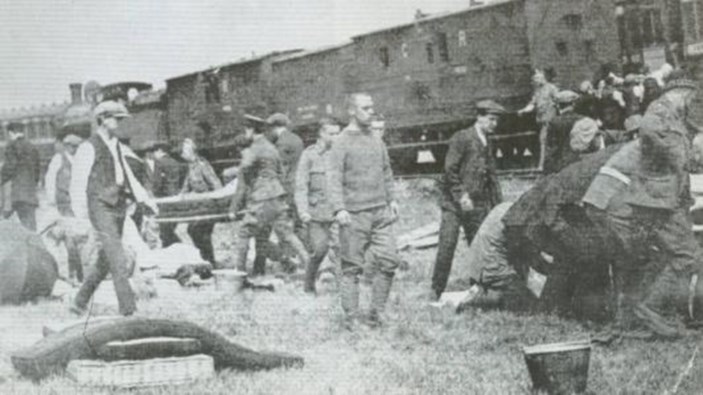
Above: The men of the Royal Scots helping their comrades. Image courtesy of The Scottish War Memorials Project.
Although some soldiers would have been killed by the impact, accounts show that within seconds of the collision, soldiers were clambering out of the carriages. Many even survived from the forward carriages – soaked with water from the tender and thrown through the air. Most of them only had slight injuries – many caused by their rifles falling from the overhead luggage racks. But many were trapped or were slowly extracting themselves from the wreckage because of their injuries. Their uninjured comrades came over to assist and also the passengers on the local train. Only now did Meakin change the signal to try to stop the Glasgow Express. It was too late, the train had passed the signal point.
The Driver of the local train emerged from under the goods train and shouted at the soldiers to get off the tracks, but wasn’t heard. The Guard of the local train and the Driver and Fireman of the coal train ran down the line as fast as they could to try to stop the express. The express train’s fireman later recounted:
…on approaching Quintinshill the signals were all clear for us. The first notice of anything being wrong was when approaching the home signal when I observed a guard waving his arms as if something was the matter. I shouted to my driver to stop, as I saw there was something in front. He came from his side of the engine to my side and immediately applied the brakes, shut off steam, and endeavoured to stop as hard as he could.
The express barely had time to slow down; the curve of the line again hindered forward visibility. Travelling at 50mph, the drivers were able to reduce speed to 40mph when the train struck the debris of the troop train carriages and the soldiers in them and those on the track.

Above: The original caption reads: “One of the express engines telescoped on top of the wreckage of the troop train. The tender (on the left) has been thrown right over the side of the track.”

Above: the Glasgow Express crashed into the wreckage
The gap between the two collisions was calculated as just 53 seconds. Six were killed on the express, plus two others were mortally injured. It is unknown how many from the troop train were killed in the second collision, as the disaster was still unfurling. The two collisions had not only caused carnage within the carriages but also ruptured the gas lighting reservoirs, which had been fully charged. Almost instantly the wreckage burst into flames. The express and coal train crews desperately tried to douse the fire with water from their tenders, but there was little left and no way to fight it effectively, particularly as undamaged gas cylinders started exploding.

Above: The train catches fire.
Describing the scene, a reporter said:
In a moment all was terrible confusion. Engines were heaped upon one another, carriages telescoped and overturned, and others mounted upon the other. Men were hurled from the train – a fortunate few well clear – others clambered out from the wreckage as best they could. Many were pinned below the overturned carriages. Already the troop train and the leading carriages of the London train were ablaze. The men still on board were in a terrible plight. The successive collisions had effectively jammed the carriage doors. Exit that way was impossible. Windows refused to come down, and the glass had to be smashed before the men could get clear.
Many were less fortunate. The flames were so hot that the steel of the express carriages buckled and twisted ‘like drying leaves’ and few attempted to fight the fire– realising that it was uncontrollable. For those still trapped, there were few options. Later interviews recorded some using their bayonets to perform self-amputations, others cutting their throats with jack-knives, while some begged an officer to shoot them. The officer complied.
The undamaged portions of the express and goods train were drawn clear and the engine of the goods train was sent to get carriages to take away the uninjured.
Local medical personnel quickly arrived and assisted the injured, all being placed in the adjoining field, where many died from shock. At 7:14 am Carlisle station was informed and proceeded to assemble a special Ambulance train, which arrived on the scene at 8.10 am. Doctors drove from Glasgow and Edinburgh, and Red Cross personnel also arrived, as did many locals, including a group of Scouts.

Above: Tending the injured. Image courtesy of Illustrated London News
The first 52 injured were put aboard the intact portion of the express and taken to Carlisle’s Cumberland Infirmary. Two more trains followed and most of the injured were evacuated by mid-day. The problems did not end there. Carlisle Hospital had just received a large number of injured soldiers from France and was overwhelmed, so the less seriously injured were moved on as far as Preston Hospital. The Red Cross commandeered several hotels and schools to help treat the injured.
At 4.00 pm, Colonel Peebles held a roll call of the battalion. Because the unit’s rolls were destroyed in the fire, he simply took down names. The train had left Larbert with 485 officers. The roll call revealed there were only 67 uninjured – only five of these from ‘A’ Company.
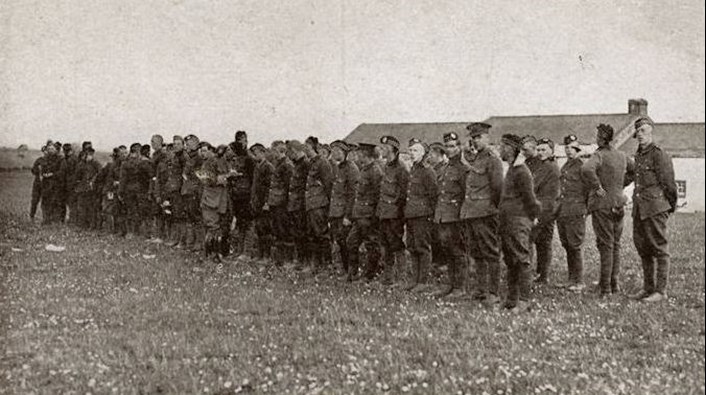
Above: The Roll Call of the 62 survivors at Quintinshill being taken by the CO Lt Col Peebles
On the following day, Sunday, back at the scene the Fire Brigade doused down the smouldering wreckage and eventually left – the fire had burnt for 23 hours. Bodies were recovered from the ashes, virtually all were unidentifiable.
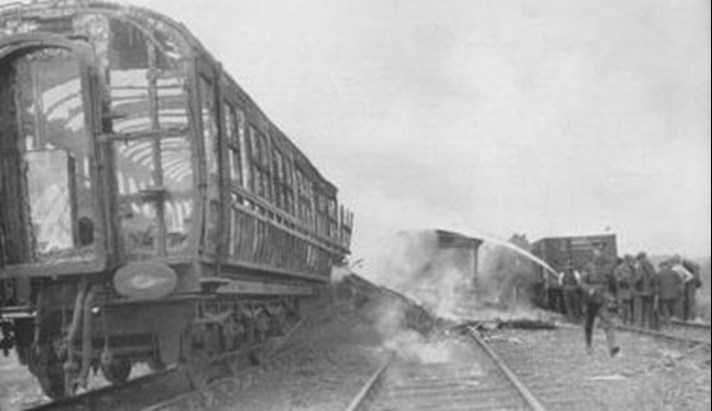
Above: Dousing the flames. Image courtesy of Illustrated London News
The last body was recovered at midday, and clearance of the scene commenced. At 8.14 pm the line reopened. Of the survivors, only Colonel Peebles and six officers were declared fit for active service. In total, the disaster killed 226 and injured a further 246.
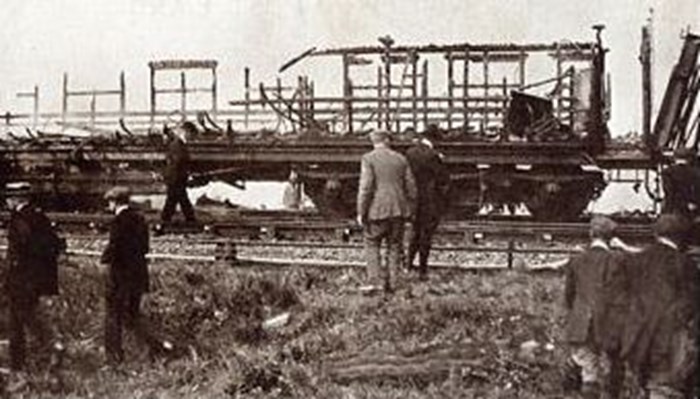
Above: The remains of a carriage.

Above: Sightseers soon came along to look at the wreck.
The survivors of the battalion were sent to Liverpool but on arrival, it was realised that they were in no fit state to go overseas. They returned to Edinburgh and took part in the funerals of their comrades.

Above: The funeral procession for the victims of the train crash - the procession passes Pilrig Church on its way to Rosebank Cemetery.
A week after the accident, Tinsley and Meakin were arrested, and they stood trial at the High Court in Edinburgh four months later. Found guilty they were sentenced to three years and 18 months respectively, but were released after a year. Bizarrely, Tinsley went back to work for the Caledonian railway as a lampman, whilst Meakin became a coal merchant, working at the Quintinshill sidings.
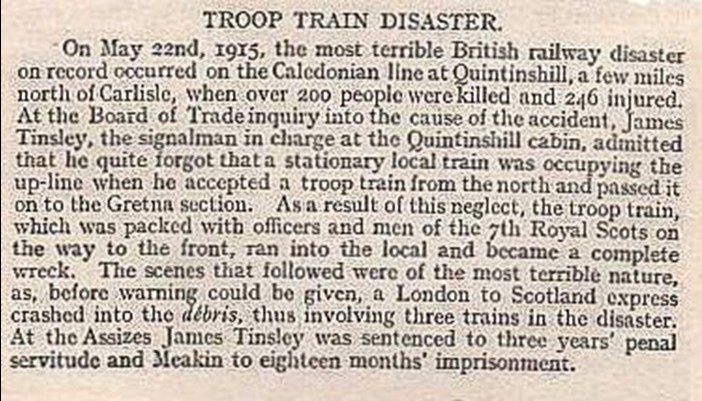
Casualties to the 1/7 Royal Scots
Of the 1028 who set off from Larbert, three Officers, 29 Non-Commissioned Officers and 182 men were killed or burned to death. All but ten of the 214 fatalities are buried at Edinburgh (Rosebank) Cemetery. The dead included Major Hamilton, Captain J M Mitchell and Lieutenant C R Salvesen.
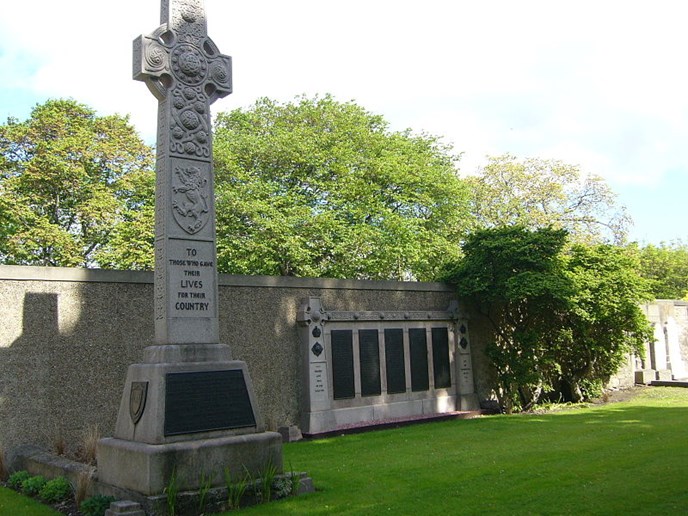
Above: Edinburgh (Rosebank) Cemetery.
Records of many of the 'other rank' fatalities can be found amongst The Western Front Association Pension Records, such as the ledger below for Private James Hollerin whose foster mother, Mrs Edith Davies was awarded a pension 'for life'.
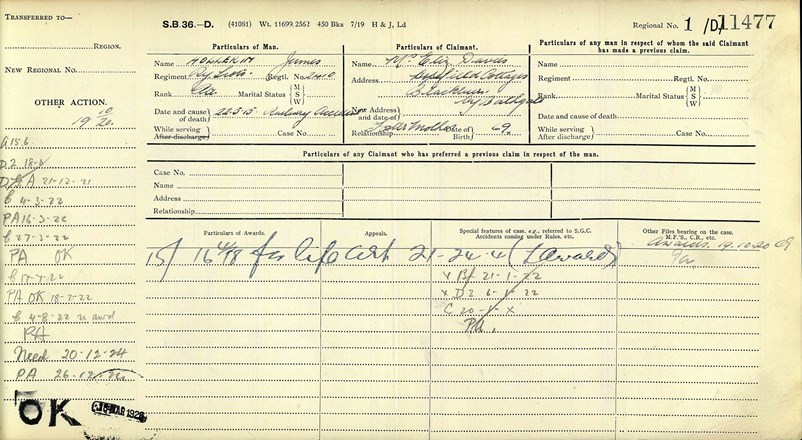
Above: The ledger showing James Hollerin died 'in a railway accident'.
The uninjured survivors of the crash, only seven officers and 57 NCOs and men were taken by train from Carlisle to Liverpool. Their shock was so profound that on reaching Liverpool the NCOs and men were sent home.
B and C Companies' train reached Liverpool earlier having made a detour and Lieutenant Colonel Peebles embarked with the 4th Battalion The Royal Scots. Eventually, the remnants of the battalion arrived at Gallipoli, they went into an attack on 28 June and suffered heavy casualties which resulted in them being down to just seven officers and 204 men.
In July they were temporarily merged with the 4th Battalion, Royal Scots and went into action again – only to lose heavily. On 3 September the battalion received reinforcements of 12 officers and 440 men – comprising survivors of the crash and men from the unit’s second line (reserve) battalion.
An analysis
This article is only intended to give an overview of this terrible accident. The main reason for the accident was the failure of Tinsley and Meakin to concentrate on their duties. Tinsley was busy writing up the register to hide his late arrival, and Meakin was distracted by chatting to men who had come into the signal box about the war news. Other technical aspects were also to blame: the shunting operation of the local train was risky but acceptable had use been made of lever collars.
The Area Today
In 1995, The Western Front Association’s Scotland Area (as it was then) unveiled a small plinth dedicated to the men who perished in the crash.

Above: The Western Front Association's cairn near the site and commemoration plaque
A further plaque on Blacksike Bridge, overlooking the scene of the accident, was unveiled on 26 September 2010.

Above: Blacksike Bridge, and the line today.
Article by David Tattersfield





